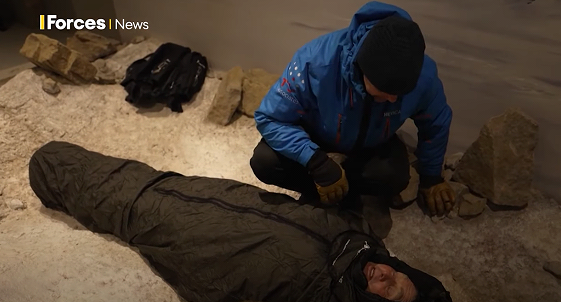


11/01/2022
Managing hypothermia and improving survival chances in austere environments – TSG equipment put to the test in Forces News
Recently, TSG put their hypothermia management products to the test under scientific conditions to assess how effectively they protect casualties from the dangers of the cold in austere environments. This was covered on an episode of Forces News in December 2021, which you can view in full on the Forces News YouTube Channel.
The challenge of patient care in austere environments
In cold environments, hypothermia poses a severe threat to casualties who are immobilised by their injuries and are unable to maintain a stable body temperature. This risk to life is exacerbated if bleeding is also present, as hypothermia becomes part of the Lethal Triad of Death, in which a combination of three conditions - hypothermia, acidosis, and coagulopathy – can accelerate the onset of organ failure and death.
Many commercial casualty management products, such as survival bags, are often impractical in austere and extreme conditions. They can be bulky or heavy to carry, lack durability or the ability to insulate effectively, so finding a solution that combines practicality, convenience, and effective insulation against extreme cold is challenging.
Putting the Xtract™SR Heatsaver to the test

At the Iqarus Immersive Training Centre in Hereford, two veterans volunteered to experience the sub-zero temperatures of the Arctic Environment Room to test the effectiveness of a potentially life-saving new kit.
Wearing only t-shirts and shorts, James and Jeff were exposed to temperatures between -2°C and -5°C, to force their core body temperature to drop to 35°C, the point at which the body becomes mildly hypothermic. Their ability to retain body heat was then monitored when they were enclosed in two different survival systems: a basic commercial survival bag and TSG’s Xtract™SR Heatsaver.
Colin, a former British Army Combat Medical Technician, recognised the problem of keeping casualties warm while crossing the Greenland Icecap unsupported. He explained, ‘when you are walking across ice caps and you’re doing that for 25 days, 9 hours a day, you have a lot of time to think… about cold injuries and how to address pre-hospital hypothermia. I looked at the sleeping bag that I was carrying which was about half of my second sledge and necessary to provide adequate insulation. My thinking questioned why we accept silver foil systems as standard to treat hypothermia in trauma patients? If that approach worked I would have happily swapped the weight and volume of my sleeping bag I was carrying and carried a foil system. My thoughts turned towards how we could develop a system that was small enough and effective enough to actually be clinically significant in the treatment of hypothermia.’
The results of the experiment were encouraging. Keeping the body’s core temperature above 35°C is critical as, below this point, there is an increased risk of death. James, who was enclosed in the survival bag, exhibited signs of considerable temperature loss from his torso, however Jeff, in the Xtract™SR Heatsaver, was able to maintain a steadier temperature, with only minimal thermal loss and not from his core.
Advantages of the Xtract™SR Heatsaver
So, how is the Xtract™SR Heatsaver different from other products?
With three key components – an inflatable mattress to protect the casualty from the ground, a bag with fibres concentrated around the core of the body and a waterproof/windproof skin – the Xtract™SR Heatsaver offers important advantages:
- Addresses all forms of heat loss.
- Effective heat retention is available soon after the point-of-wounding.
- Can be integrated with active heating solutions.
- Micro-sized design for practicality and portability.
- Comfort maximises the casualty’s outcomes at acute and prolonged care phases.
Contact TSG Associates to find out more
To find out more about our hypothermia management solutions, please get in touch.








